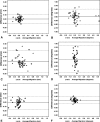Accuracy of model-based RSA contour reduction in a typical clinical application
- PMID: 18509712
- PMCID: PMC2584241
- DOI: 10.1007/s11999-008-0287-3
Accuracy of model-based RSA contour reduction in a typical clinical application
Abstract
Marker-based roentgen stereophotogrammetric analysis (RSA) is an accurate method for measuring in vivo implant migration, which requires attachment of tantalum markers to the implant. Model-based RSA allows migration measurement without implant markers; digital pose estimation, which can be thought of as casting a shadow of a surface model of the implant into the stereoradiographs, is used instead. The number of surface models required in a given clinical study depends on the number of implanted sizes and design variations of prostheses. Contour selection can be used to limit pose estimation to areas of the prosthesis that do not vary with design, reducing the number of surface models required. The effect of contour reduction on the accuracy of the model-based method was investigated using three different contour selection schemes on tibial components in 24 patients at 3 and 6 month followup. The agreement interval (mean +/- 2 standard deviations), which bounds the differences between the marker-based and model-based methods with contour reduction was smaller than -0.028 +/- 0.254 mm. The data suggest that contour reduction does not result in unacceptable loss of model-based RSA accuracy, and that the model-based method can be used interchangeably with the marker-based method for measuring tibial component migration.
Figures





Similar articles
-
Experimental analysis of Model-Based Roentgen Stereophotogrammetric Analysis (MBRSA) on four typical prosthesis components.J Biomech Eng. 2009 Apr;131(4):041004. doi: 10.1115/1.3072892. J Biomech Eng. 2009. PMID: 19275433
-
Comparison of the model-based and marker-based roentgen stereophotogrammetry methods in a typical clinical setting.J Arthroplasty. 2009 Jun;24(4):594-606. doi: 10.1016/j.arth.2008.02.004. Epub 2008 Aug 3. J Arthroplasty. 2009. PMID: 18676114
-
Model-based Roentgen stereophotogrammetry of orthopaedic implants.J Biomech. 2001 Jun;34(6):715-22. doi: 10.1016/s0021-9290(01)00028-8. J Biomech. 2001. PMID: 11470108
-
[Early assessment of the risk of later implantloosening using Roentgen Sterophotogrammetric Analysis (RSA)].Orthopade. 2020 Dec;49(12):1042-1048. doi: 10.1007/s00132-020-04027-y. Orthopade. 2020. PMID: 33108489 Review. German.
-
Roentgen stereophotogrammetric analysis of prosthetic fixation in the hip and knee joint.Clin Orthop Relat Res. 1992 Mar;(276):56-65. Clin Orthop Relat Res. 1992. PMID: 1537175 Review.
Cited by
-
Relationship of anterior knee laxity to knee translations during drop landings: a bi-plane fluoroscopy study.Knee Surg Sports Traumatol Arthrosc. 2011 Apr;19(4):653-62. doi: 10.1007/s00167-010-1327-6. Epub 2010 Dec 11. Knee Surg Sports Traumatol Arthrosc. 2011. PMID: 21153545 Free PMC article.
-
High knee valgus in female subjects does not yield higher knee translations during drop landings: a biplane fluoroscopic study.J Orthop Res. 2013 Feb;31(2):257-67. doi: 10.1002/jor.22217. Epub 2012 Sep 11. J Orthop Res. 2013. PMID: 22968826 Free PMC article.
-
Error performances of a model-based biplane fluoroscopic system for tracking knee prosthesis during treadmill gait task.Med Biol Eng Comput. 2018 Feb;56(2):307-316. doi: 10.1007/s11517-017-1680-4. Epub 2017 Jul 18. Med Biol Eng Comput. 2018. PMID: 28726074
-
A high offset stem design does not increase stem migration under full weight bearing in cementless total hip arthroplasty: a model-based RSA study.Arthroplasty. 2025 Feb 4;7(1):7. doi: 10.1186/s42836-024-00290-y. Arthroplasty. 2025. PMID: 39901296 Free PMC article.
-
Adherence of hip and knee arthroplasty studies to RSA standardization guidelines. A systematic review.Acta Orthop. 2014 Sep;85(5):447-55. doi: 10.3109/17453674.2014.934187. Epub 2014 Jun 23. Acta Orthop. 2014. PMID: 24954489 Free PMC article.
References
-
- {'text': '', 'ref_index': 1, 'ids': [{'type': 'DOI', 'value': '10.1109/10.495283', 'is_inner': False, 'url': 'https://doi.org/10.1109/10.495283'}, {'type': 'PubMed', 'value': '8987268', 'is_inner': True, 'url': 'https://pubmed.ncbi.nlm.nih.gov/8987268/'}]}
- Banks SA, Hodge WA. Accurate measurement of three-dimensional knee replacement kinematics using single-plane fluoroscopy. IEEE Trans Biomed Eng. 1996;43:638–649. - PubMed
-
- {'text': '', 'ref_index': 1, 'ids': [{'type': 'DOI', 'value': '10.1302/0301-620X.81B2.8842', 'is_inner': False, 'url': 'https://doi.org/10.1302/0301-620x.81b2.8842'}, {'type': 'PubMed', 'value': '10204933', 'is_inner': True, 'url': 'https://pubmed.ncbi.nlm.nih.gov/10204933/'}]}
- Biedermann R, Krismer M, Stockl B, Mayrhofer P, Ornstein E, Franzen H. Accuracy of EBRA-FCA in the measurement of migration of femoral components of total hip replacement. Einzel-Bild-Rontgen-Analyse-femoral component analysis. J Bone Joint Surg Br. 1999;81:266–272. - PubMed
-
- {'text': '', 'ref_index': 1, 'ids': [{'type': 'PubMed', 'value': '2868172', 'is_inner': True, 'url': 'https://pubmed.ncbi.nlm.nih.gov/2868172/'}]}
- Bland JM, Altman DG. Statistical methods for assessing agreement between two methods of clinical measurement. Lancet. 1986;1:307–310. - PubMed
-
- {'text': '', 'ref_index': 1, 'ids': [{'type': 'DOI', 'value': '10.1016/j.jbiomech.2005.05.004', 'is_inner': False, 'url': 'https://doi.org/10.1016/j.jbiomech.2005.05.004'}, {'type': 'PubMed', 'value': '15990104', 'is_inner': True, 'url': 'https://pubmed.ncbi.nlm.nih.gov/15990104/'}]}
- Borlin N, Rohrl SM, Bragdon CR. RSA wear measurements with or without markers in total hip arthroplasty. J Biomech. 2006;39:1641–1650. - PubMed
-
- {'text': '', 'ref_index': 1, 'ids': [{'type': 'PubMed', 'value': '8175848', 'is_inner': True, 'url': 'https://pubmed.ncbi.nlm.nih.gov/8175848/'}]}
- Freeman MA, Plante-Bordeneuve P. Early migration and late aseptic failure of proximal femoral prostheses. J Bone Joint Surg Br. 1994;76:432–438. - PubMed
Publication types
MeSH terms
LinkOut - more resources
Full Text Sources

